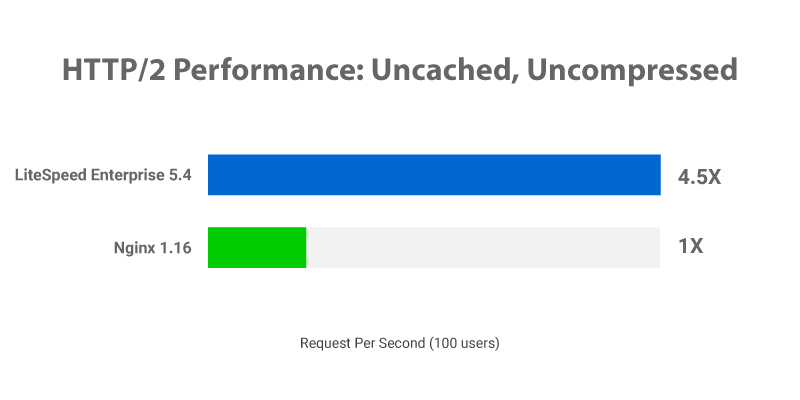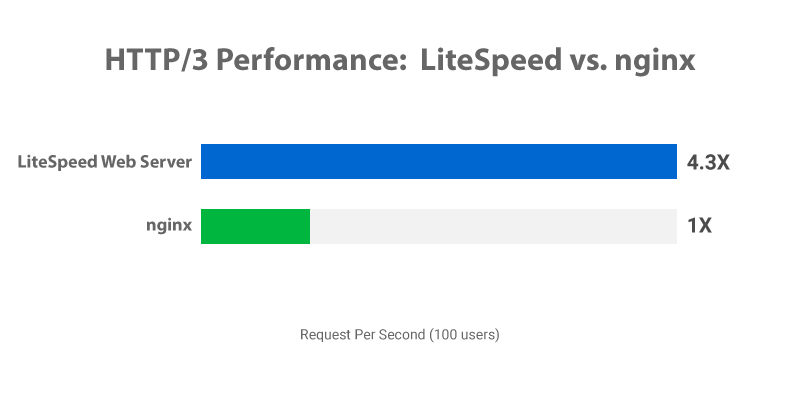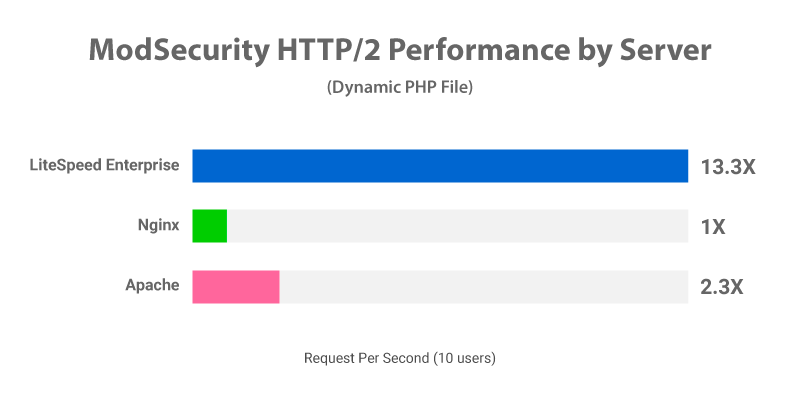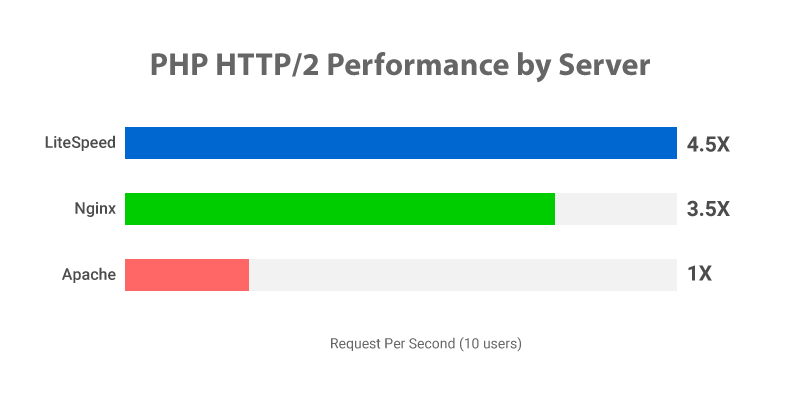Outstanding Performance from Every Angle
LiteSpeed's 100% software-based solutions are built from the ground up to maximize the performance of your existing infrastructure.

Fine Tuned HTTP/2 Engine, Ultimate SSL Performance

More than a third of the world's websites currently use HTTP/2, up from less than a quarter of sites the previous year. As the protocol grows in popularity, HTTP/2 performance has become a crucial metric for all modern web servers.
With direct TLS record packaging, LiteSpeed's HTTP/2 implementation minimizes data copies, decreases buffer bloating, improves TTFB (time to first byte), and allows effective HTTP/2 stream prioritization.
This translates into measurably better performance than other HTTP/2 servers.
Don't believe it? Our benchmarks are easily repeatable and verifiable in your own environment. See http2benchmark.org for details!
Stability, Performance in an Innovative HTTP/3 QUIC Engine

Once again, LiteSpeed is ahead of the curve with the first ever production-grade HTTP/3 web server implementation. HTTP/3, the new Internet protocol based on QUIC, continues to be defined by the IETF, but with every step, we are there, keeping our implementation current and cutting-edge.
Performance, as always, is a priority, and LiteSpeed's rock solid HTTP/3 does not disappoint!
Performance Tuned ModSecurity (WAF) Engine
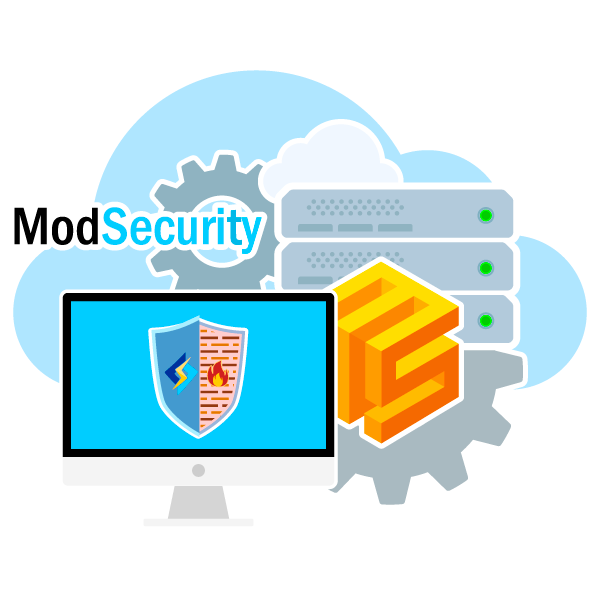
A Web Application Firewall (WAF) is an important component in server security, but ModSecurity implementations can have a negative impact on server performance. LiteSpeed minimizes that impact with a proprietary WAF engine, built with speed and efficiency in mind.
When pitted against nginx and Apache's ModSecurity engines in a series of benchmarks, LiteSpeed Enterprise's implementation is the clear winner every time.
Cache Acceleration for Popular Web Applications

Other servers require a separate cache layer, like Varnish, to sit on top of the stack. But LiteSpeed's cache engine is built directly into LiteSpeed Web Server, making for a shorter, more efficient stack.
LiteSpeed's intelligent cache engine is an essential component of any web app acceleration strategy. Our cache plugins are the secret to speeding up popular web apps like WordPress, Joomla, Magento, Drupal, PrestaShop and many more.
As a server-level cache, LiteSpeed Cache has the ability to dramatically speed up delivery of dynamic content. Full ESI support ensures that eCommerce sites with both public and private content may be completely cached: even when mixed content appears on a single page! When your entire site is cached, your entire site is FAST.
High Performance Open-Source PHP LiteSpeed SAPI

LiteSpeed's own PHP SAPI is built for high performance. When compared to PHP-FPM (FastCGI), the LSAPI protocol is faster and more efficient. In fact, CloudLinux chose LiteSpeed SAPI as the basis for their Apache mod_lsapi, because LiteSpeed's performance was that much better.
Benchmarks show LSAPI is consistently faster than PHP-FPM!
Full .htaccess Support Without the Performance Hit
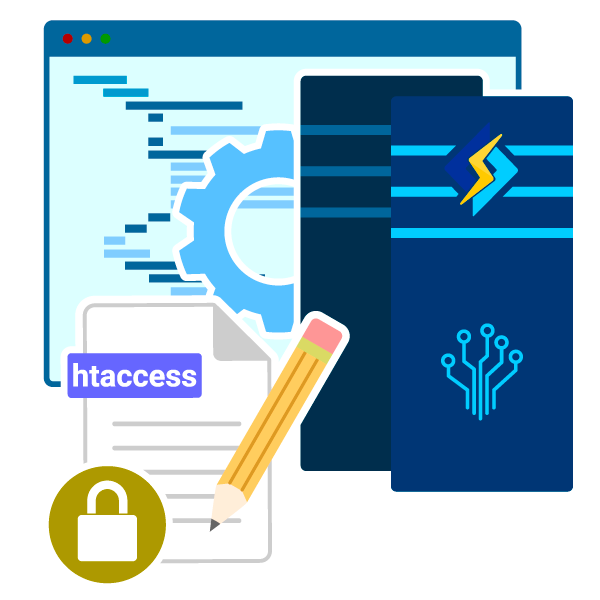
Apache performance suffers when processing its .htaccess configuration file. Each request must traverse the full path to load and process .htaccess on the fly. This performance penalty is one of the reasons why nginx doesn't support .htaccess at all.
This is not a problem for LiteSpeed, though! We utilize a built-in .htaccess cache, and only update when the configuration has changed. Caching .htaccess is challenging, because it requires merging multiple layers of config files into a single ready-to-use configuration unit. (This difficulty is likely the reason why Apache has never attempted an .htaccess cache over the years.)
LiteSpeed's ability to cache .htaccess is yet another reason why LiteSpeed Web Server performes better than Apache every time.
State-of-the-art Event-Driven Architecture

LiteSpeed's foundation is it's high-performance event-driven core.
Not all event-driven servers are created equally. The biggest challenge for an event-driven application is to keep the event loop free from blockage. With more and more cores packed into modern CPUs, how does a single-CPU event loop utilize the extra resources available? LiteSpeed's innovative solution is helper threads.
Helper threads are used to offload operations that could cause an event loop to block. This includes, but is not limited to, reading a static file from disk, logging, and CPU-intensive operations like SSL handshake, and heavy regular expression matching.
By utilizing helper threads, LiteSpeed keeps the event loop moving smoothly, and the server running fast.

